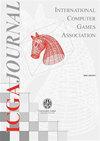洛斯阿拉莫斯国际象棋第 2 局(P-K3 之后)已解;黑棋 21 步获胜
IF 0.1
4区 计算机科学
Q4 COMPUTER SCIENCE, SOFTWARE ENGINEERING
引用次数: 0
摘要
人工智能(AI)领域的一个决定性事件是,1956 年人类与计算机之间进行了第一场国际象棋对弈(《国际象棋评论》(1957 年)13-17;《机器下国际象棋》(1978 年)Pergamon 出版社)。在这场比赛中,普林斯顿大学的马丁-克鲁斯卡尔(Martin Kruskal)博士执白对阵由保罗-斯坦(Paul Stein)和马克-威尔斯(Mark Wells)编程的新墨西哥州洛斯阿拉莫斯科学实验室的 MANIAC I 计算机。由于当时计算机的处理能力非常有限,无法处理完整的8×8棋盘,因此对局双方下的是 "洛斯阿拉莫斯棋",一种使用6×6棋盘、不含象的小型国际象棋变体。在这盘棋中,白方没有后,以P-K3开局,最终在38步内战胜了机器对手。这里我们将证明黑方可以在21步内取胜。本文章由计算机程序翻译,如有差异,请以英文原文为准。
Los Alamos chess game 2 (after P-K3) is solved; black wins in 21 moves
In a defining event for the field of Artificial Intelligence (AI), the first game of chess skill between a human and computer took place in 1956 (Chess Review (1957) 13–17; The Machine Plays Chess? (1978) Pergamon Press). In this match, Dr Martin Kruskal from Princeton University played White against the MANIAC I computer at Los Alamos Scientific Laboratory in New Mexico, programmed by Paul Stein and Mark Wells. Due to the very limited capacity of computers at the time, which couldn’t handle a full 8×8 chess board, the competitors played “Los Alamos Chess”, a minichess variant using a 6×6 board without bishops. For this game, White played without a queen, opened with P-K3 and ultimately won against the machine opponent in 38 moves. Here we show that Black can force a win in 21 moves.
求助全文
通过发布文献求助,成功后即可免费获取论文全文。
去求助
来源期刊

Icga Journal
工程技术-计算机:软件工程
自引率
25.00%
发文量
16
期刊介绍:
The ICGA Journal provides an international forum for computer games researchers presenting new results on ongoing work. The editors invite contributors to submit papers on all aspects of research related to computers and games. Relevant topics include, but are not limited to:
(1) the current state of game-playing programs for classic and modern board and card games
(2) the current state of virtual, casual and video games
(3) new theoretical developments in game-related research, and
(4) general scientific contributions produced by the study of games.
Also welcome is research on topics such as:
(5) social aspects of computer games
(6) cognitive research of how humans play games
(7) capture and analysis of game data, and
(8) issues related to networked games are invited to submit their contributions.
 求助内容:
求助内容: 应助结果提醒方式:
应助结果提醒方式:


